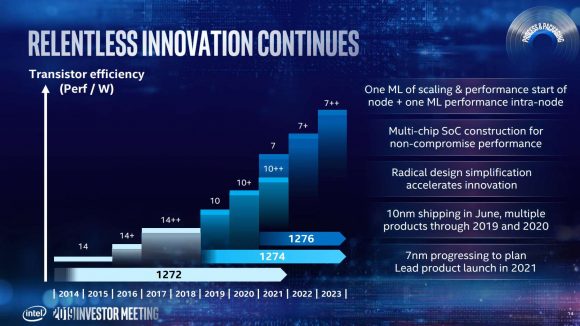October 15, 2019 Updated with Intel’s official response to the salty rumours.
It was rumoured that Intel had taken the decision to ditch the 10nm production process for its desktop CPUs and was instead set to jump straight from the 14nm+++ lineup into 7nm desktop processors. Given all the problems it’s had with chip development and production yields that wouldn’t seems like a bad move… except that it wouldn’t happen for at least two years.
Intel has now responded, promising that its “current roadmap of 10nm products includes desktop.” Which is more promising than the speculation, and intimates that we may indeed get some 10nm gaming chips, and more importantly see the Sunny Cove microarchitecture on the desktop.
Some previous rumours had suggested that Intel’s desktop line is going to be stuck to the same 14nm lithography it’s been using since Broadwell introduced us to it way back in 2014. The Rocket Lake-S processors have long been suggested as another 14nm CPU launching in the second quarter of 2021, with the upcoming Comet Lake-S chips set to fill the time between then and now.
This was, of course a heavily salted rumour, coming as it did from so-called ‘insiders,’ so the veracity of the claims had to be treated with a certain level of caution. It did, however, tally squarely with the existing expectations about Intel’s future desktop game. The response provided to us from Intel, however, seemingly puts 10nm squarely on the desktop.
“We continue to make great progress on 10nm, and our current roadmap of 10nm products includes desktop,” says the official Intel statement. “The benefits in any new process technology are realised across different products to meet varying customer needs overtime. For example, the new 10th Gen Intel Core processors (Ice Lake) for mobile clients are designed for outstanding graphics performance and deliver up to 2x graphics performance while maintaining platform power efficiency.”
The original claims came from “Insiderkreisen” speaking to Andreas Schilling at HardwareLuxx, who he notes have proven to be accurate on CPU topics multiple times in the past. The points being that, because Intel is struggling to hit the required clock speeds for a 10nm desktop chip to be able to surpass the previous performance of its 14nm silicon, it’s had to nix any desktop development of 10nm cores.
Instead, it posited, Intel will be using Comet Lake-S and Rocket Lake-S ranges – both still based on the existing Skylake CPU architecture – to fill the gap until Intel hits the 7nm ground running with Meteor Lake in 2022. Three years after AMD has hit volume release of its own 7nm CPUs. Ouch.
By then we might have already had a year of 5nm AMD Ryzen chips based on the Zen 4 microarchitecture, which means Intel will still potentially have a lot of catching up to do to its CPU rivals.
That would mean, like Ice Lake, there would be no desktop equivalent of the Tiger Lake mobile processors. Which would have been a real shame because then the Sunny Cove core design wouldn’t make it into our desktop gaming rigs, and we wouldn’t get the at least 15% IPC increase it’s delivered to its laptop chips.
It’s not clear why the Sunny Cove design can’t be back-ported onto the 14nm lithography; it might be that the new architecture needs the extra die-space afforded by the smaller production process, or the reduced power requirements. But for now it certainly looks like the desktop market for Intel CPUs is going to remain relatively stagnant in terms of actual chip design for another few years at least.
We don’t know which of the Coves the 7nm Meteor Lake architecture might sport, but given that we’re looking around three years in the future the advanced Golden Cove design, with its boosted AI and single threaded performance boosts, might not be out of the question.
The source puts some of the blame for the 10nm struggles at the feet of a new technique called Contact Over Active Gate (COAG). The technique has reportedly by tricky and was the main stumbling block behind the now-defunct Cannon Lake CPUs. With low production clock speeds and the problems with new techniques it’s no surprise that Intel might want to skip 10nm on the desktop and tread water until 2022.
After all, it’s not like the current lineup of 14nm processors is actually struggling in terms of performance. For all that we laud AMD for nailing its 7nm CPU, and for offering a vast number of cores via its chiplet design, Intel’s aging Skylake architecture is still capable of hitting high clock speeds on a process that’s nominally twice the scale, and producing IPC metrics still often above AMD’s finest.


